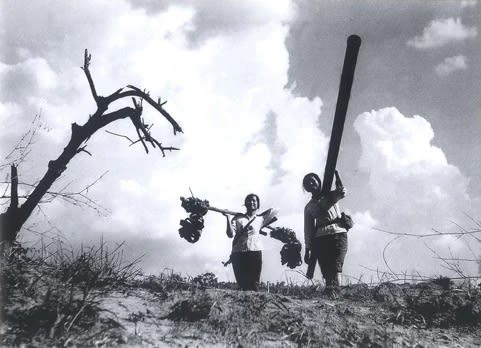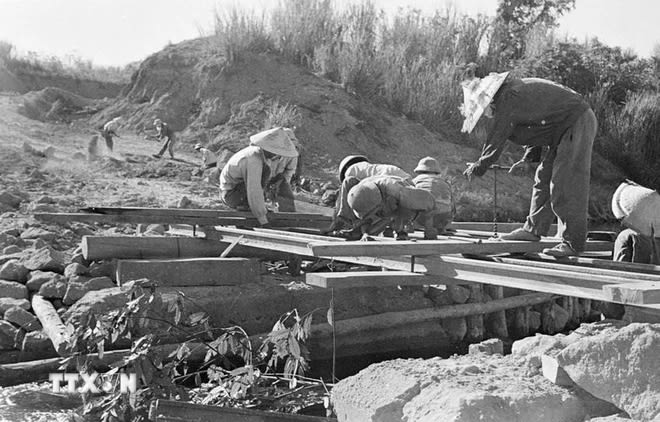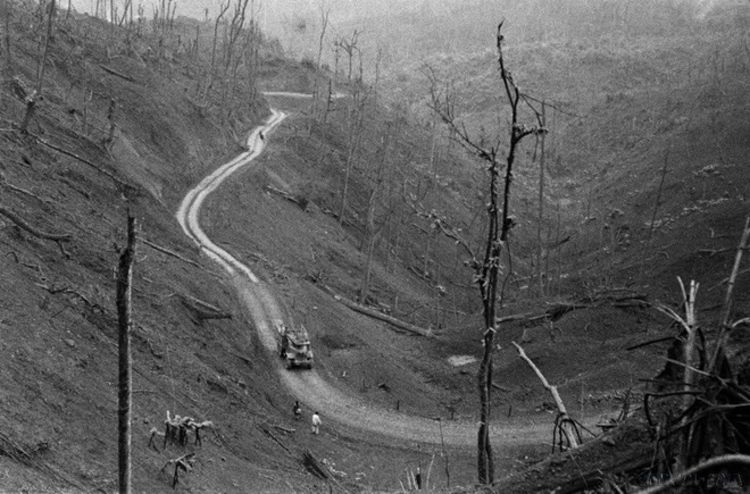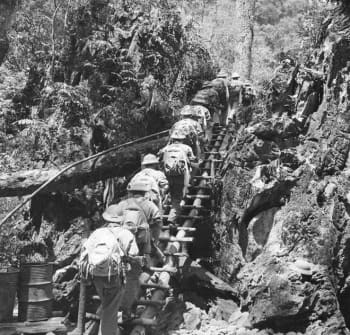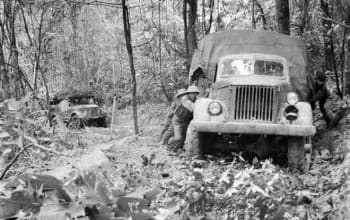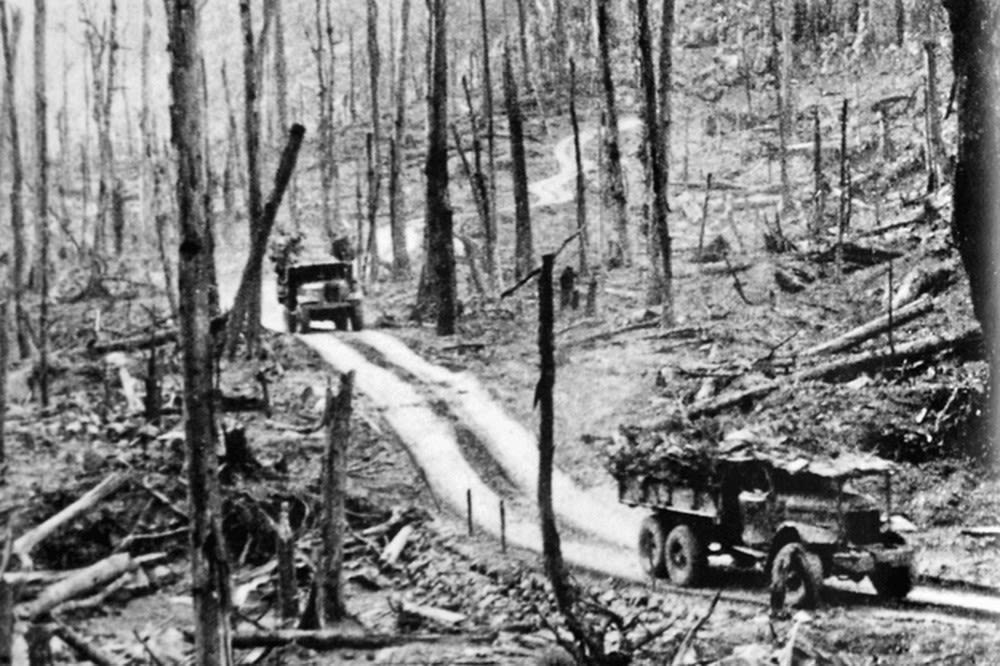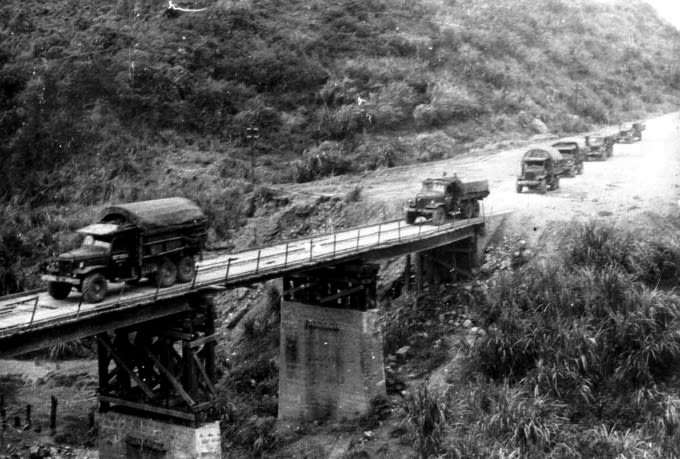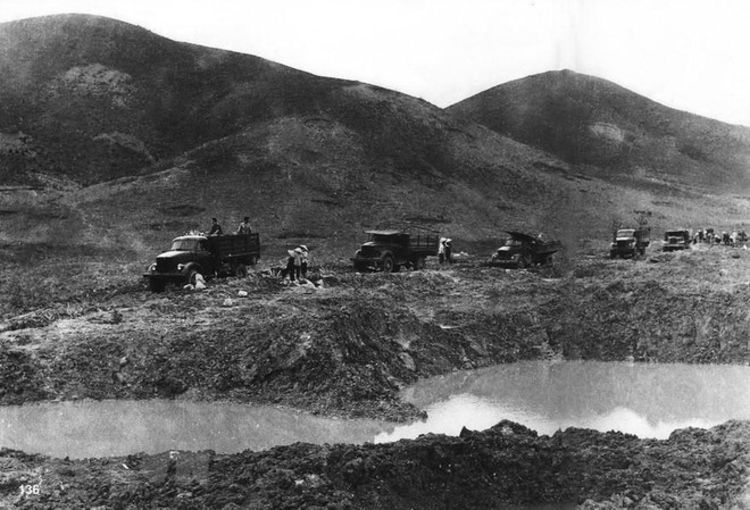Commemorating the 55th anniversary of the opening of the Ho Chi Minh Trail and the traditional day of the Truong Son Soldiers
THERE WAS A TRUONG SON TRAIL UNDERGROUND
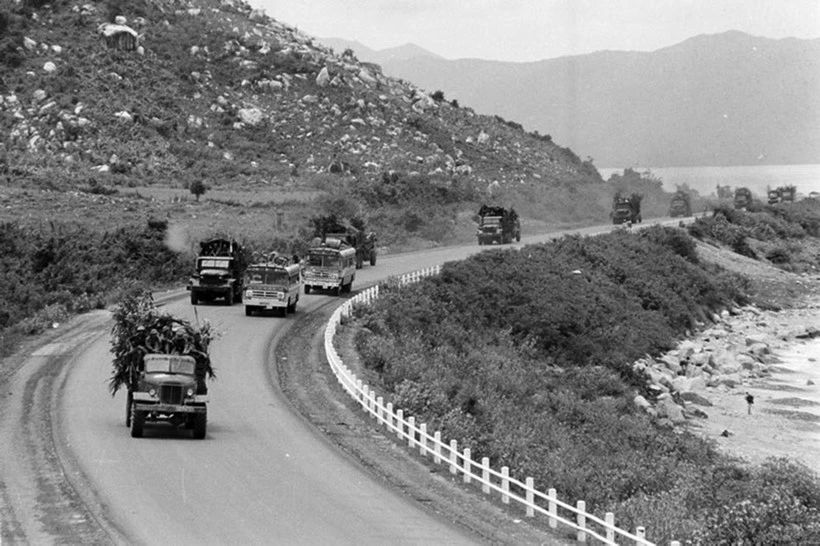
Soldiers carrying pipeline sections. (File photo)
Soldiers carrying pipeline sections. (File photo)
Within the seven years from 1968 to1975, the Truong Son soldiers built an underground oil pipeline spanning more than 1,400 kilometres, extending from the socialist North to the southern province of Binh Phuoc. Many people fell to keep the fuel pipeline flowing smoothly to the South.
The legendary pipeline
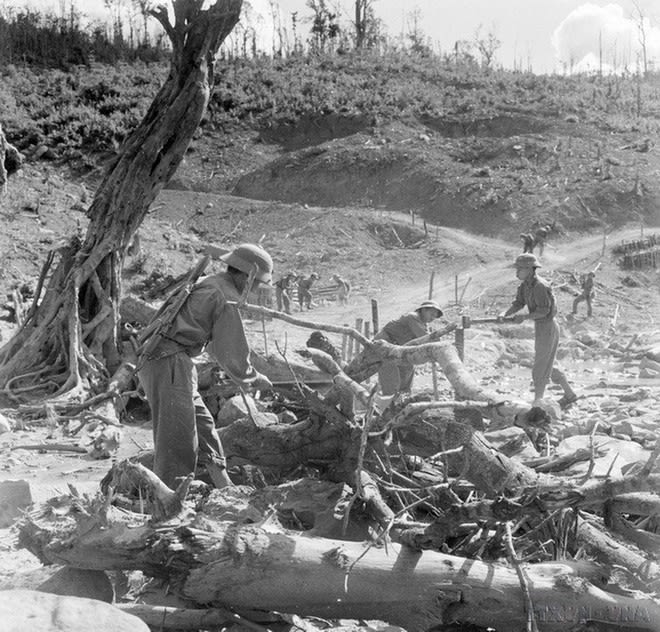
In March 1968, US air forces heavily bombed the areas from Ben Thuy ferry to Nam Dan and Dong Loc T-junction to cut off the vital supply line to the South. Colonel Dinh Cong Ty, former political commissar of the 11th Transport Regiment of the 559th Army Corps, recalled: “At that time, we ran out of fuel for our vehicles. Sometimes, thousands of transport vehicles were stranded waiting for fuel, with the camouflage leaves on the vehicles withering many times over while still waiting on fuel. Due to the fuel shortage, we couldn’t transport ammunition, food and military supplies to the battlefield. The situation was dire as there was a shortage of rice and salt, with each soldier’s rations reduced to just 200-400 grams of rice per day.
According to the history of the Truong Son Command (Group 559), Station 12 was at that time stationed in Khe Ve (Quang Binh) and had a large amount of gasoline. However, it could not supply it outside because bombs and bullets had destroyed the roads. Moreover, rainfall had left the entire Khe Ve area like a swamp. The station had to pump gasoline into 200-liter petrol drums and assign four soldiers to carry them across the swamp. However, in one day, three groups of soldiers (12 people) could carry only 15 petrol drums, meaning in two days they could only transport enough gasoline for two trucks. However, during those days of transporting gasoline, one Station 12 soldier slipped and fell into a ravine, and two soldiers were killed by mines.
Despite the frantic bombing by American aircraft, the engineers of Cau D, Quang Binh, still stuck to the road day and night, building bridges for vehicles to reach the front line, ensuring the traffic artery between the rear and the front line, August 1968. (Photo: Chi Thanh/VNA)
Despite the frantic bombing by American aircraft, the engineers of Cau D, Quang Binh, still stuck to the road day and night, building bridges for vehicles to reach the front line, ensuring the traffic artery between the rear and the front line, August 1968. (Photo: Chi Thanh/VNA)
An initiative approach to carry gasoline through the mud was carried out by the entire Station 12. The gasoline was wrapped in plastic bags (20 litres per bag) and then put into backpacks for each person to carry through the key point. After a day of wading through the mud carrying gasoline, with bombs and bullets flying overhead, 500 soldiers could only transport 10 cubic metres of gasoline, enough for two trucks. 40 soldiers were burned, and some died from lead poisoning. That's why Station 12 came up with the idea of building a pipeline to transport gasoline through the pass.
Initially, the pipeline was made of rolled corrugated iron connected by rubber pins. When the corrugated iron ran out, Station 12 used hollowed bamboo pipes instead. The pump would pump gasoline from the northern slope of the pass through the pipeline to the storage tank (200-liter drum) at the top of the pass. Then the gasoline would flow down the southern slope of the pass. The initiative reduced the sacrifice of soldiers, but the amount of gasoline lost was quite large.
It is necessary to restore the most typical sections of the entire oil and gas pipeline (including the pipeline, pumping station and fuel depot) so that the people in the country and international friends know about the miracle of “Truong Son underground” and to educate the tradition for today's and future generations.
At the same time, Station 14 could not transport gasoline because Road 20 Quyet Thang was hit by 30 to 40 bombs per day. According to the memory of Colonel Hoang Tra, former Chief of Station 14, the troops tied barrels of gasoline into rafts and let them drift down the Nay River to the Son River. After that, the soldiers pushed the gasoline rafts up the Son River to transport them. “However, most of the gasoline rafts were hit by enemy mines, the gasoline and the soldiers’ blood mixed together, and many people laid down their lives”, said Tra.
After that, Station 14 organised teams to transport barrels of gasoline upstream on Tra Ang River at night. However, the enemy continued to scout and bomb the area, causing flames to engulf the river's surface. On the first night, 20 barrels were transported, however the lives of nine soldiers were claimed. On the second night, 30 barrels were moved, with an additional 29 soldiers losing their lives in Tra Ang River.
According to the history of the Truong Son High Command, due to significant losses and the critical mission of ensuring fuel for transportation into Truong Son, the Central Military Commission established and assigned the Petroleum Department to create a pipeline through the mountains and forests to the south.
From small trails, the Ho Chi Minh Trail evolved into a major transportation route for transporting troops and supplies to support the southern battlefield. (Photo: Van Sac/VNA)
From small trails, the Ho Chi Minh Trail evolved into a major transportation route for transporting troops and supplies to support the southern battlefield. (Photo: Van Sac/VNA)
On the night of June 12, 1968, over 400 engineers and workers from the Ministry of Light Industry, Ministry of Water Resources, and Thai Nguyen Iron and Steel Company secretly travelled from Hanoi to Nam Dan (Nghe An Province), just 500 meters from a heavily bombed area, to work on connecting pipes across Lam River. They worked continuously for ten nights and completed the first 500 meters of piping by June 23, 1968.
From there, pipes were further connected across La River (Ha Tinh Province) to Warehouse N1 of the Petroleum Department. Subsequently, pipes were extended down to Khe Ve, crossing Mu Gia Pass (Quang Binh Province) into Laos. Fuel was then transported along Truong Son West down Route 9 (Quang Tri Province) before returning to Vietnam or continuing along Truong Son West into battlefields in Region 5, the Central Highlands, and the Southeast, avoiding areas that were often attacked by the enemy.
Major General Phan Khac Hy, former Deputy Commander of the Truong Son Army, reminisced: “On March 3, 1969, the first pipeline across the Truong Son Mountain range was completed, stretching 350 kilometres, connecting Vinh (Nghe An) to Ka Vat Depot in Laos. Just six days later, over 5,000 vehicles from Group 559 resumed transporting supplies to the southern front. To conceal the operation, pipelines and booster pump stations were buried underground or hidden in caves. When crossing rivers and streams, the pipelines were secured like suspension bridges.”
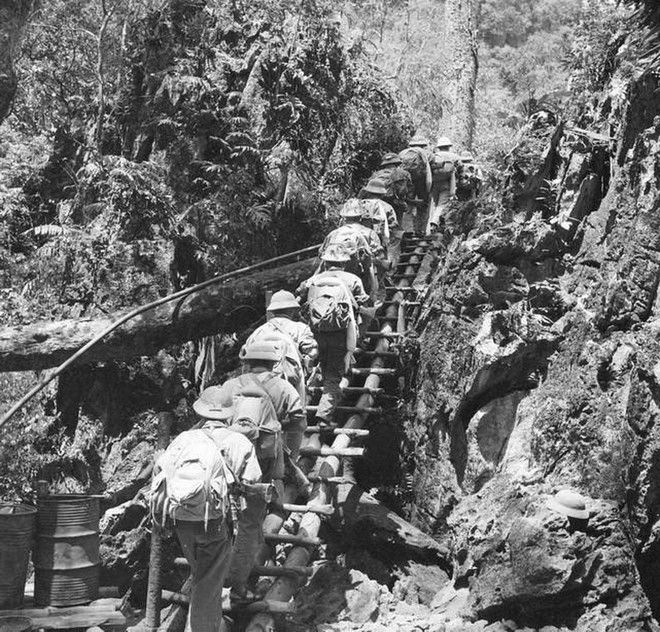
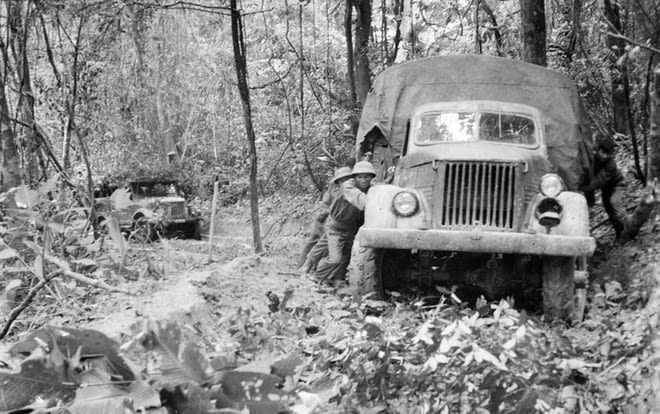
The historic Truong Son Road (Photo: VNA)
The historic Truong Son Road (Photo: VNA)
The Truong Son Road was a vital route in supporting South Vietnam.
The Truong Son Road was a vital route in supporting South Vietnam.
Group 559’s military convoys transported goods to the battlefield, braving the key enemy focal point of Dong Loc T-junction in Nghe Tinh. (Photo: Van Sac/VNA)
Group 559’s military convoys transported goods to the battlefield, braving the key enemy focal point of Dong Loc T-junction in Nghe Tinh. (Photo: Van Sac/VNA)
Journey to history

According to Major General Phan Khac Hy, within just seven years (from June 1968 to June 1975), the soldiers of Truong Son constructed the nearly 5,000-kilometre-long "Truong Son Trail underground" with many main and branching oil pipelines, running from socialist Northern Vietnam all the way to the final stretch in Binh Phuoc. This legendary achievement is little known due to its secretive construction and the pipeline being buried underground. After the southern liberation and national reunification, the pipeline system was left almost abandoned, quietly standing as a legend in the forests. But now, where the pipeline system exists is uncertain.
Fortunately, right at the Indochina Crossroads, Lieutenant Colonel Nguyen Van Yen, head of the border guard station at the Bo Y International Border Gate, confirmed: "In 1984, we followed the locals to the B3 warehouse of Regiment 559, located 17 kilometres from the Sa Den Village in Phu Vong District, Attapeu Province, Laos, and found many oil pipes. Later, we carried the pipes back to our unit to use them for making columns, beams, and barriers."
Major General Phan Khac Hy said it is essential to restore the most iconic sections of the entire petroleum pipeline system (including the pipes, pumping stations, and fuel storage depots) so that Vietnamese people and international friends can understand the incredible achievement of the "Underground Truong Son Trail" and to educate future generations about this historical milestone.
Content: Duong Minh Anh
Design: Diec Duong
Photos: VNA

